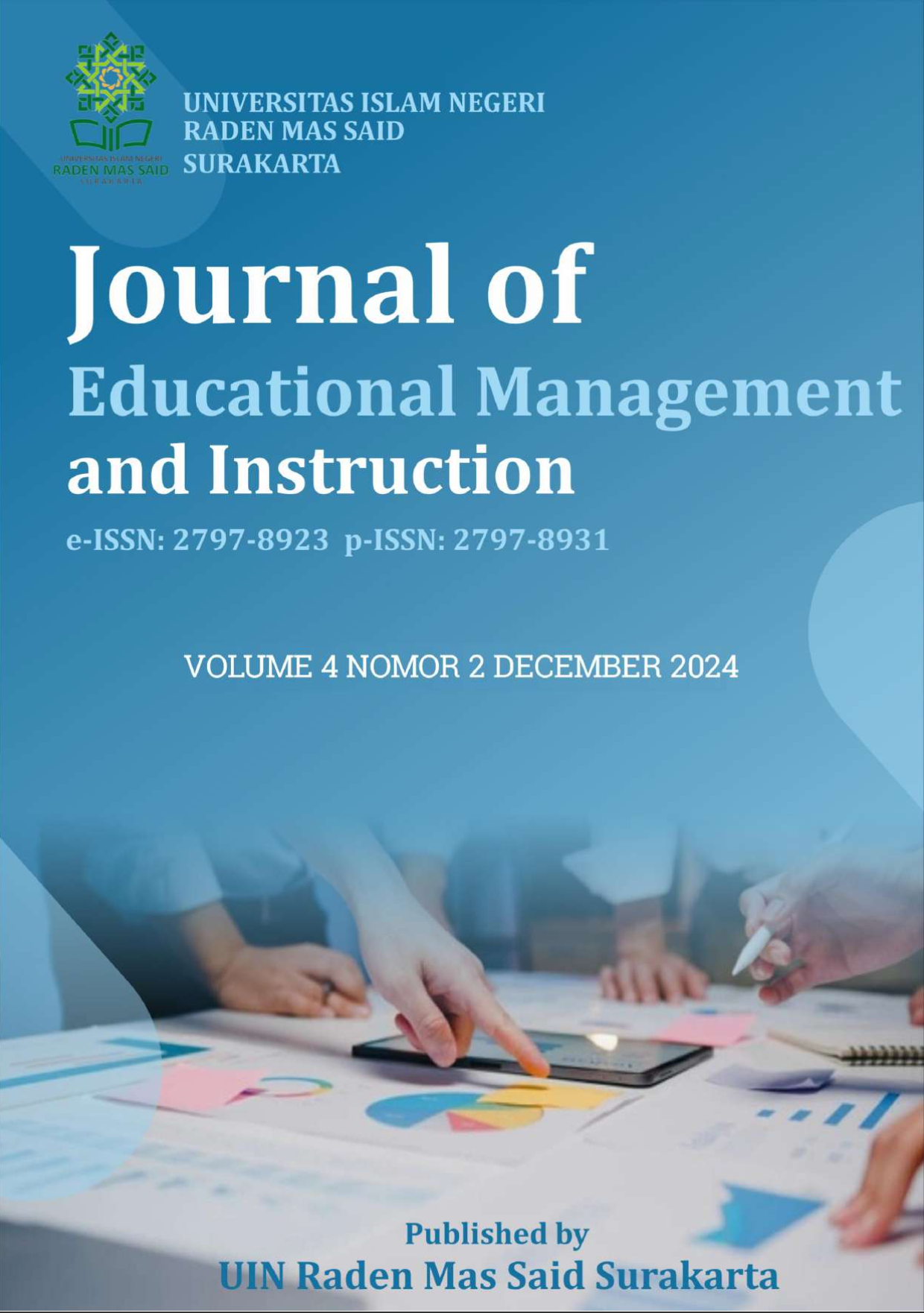Exploring how video conferencing impacts students' cognitive, emotional, and behavioral engagement
DOI:
https://doi.org/10.22515/jemin.v4i2.9335Keywords:
English as a Foreign Language, Learning Management System, Online Learning Students Engagement, Video ConferenceAbstract
Video conferencing has become an essential tool in the realm of education, offering educators a plethora of features to enhance student learning. This study delved into the comparative impact of video conferencing and Learning Management Systems (LMS) on student engagement in online education. The primary objective was to discern the most effective mode of communication for fostering student engagement in online learning, examining cognitive, emotional, and behavioral dimensions of engagement. The researchers used a quasi-experimental design with a historical cohort control group to compare the effectiveness of Zoom and Moodle (LMS) on student engagement. The study involved English education students from a private university in Indonesia, with 20 students in each group. Data collection included recording online interactions, conducting semi-structured interviews, and administering a Likert-style survey. Data analysis involved content analysis, thematic analysis, and the Mann-Whitney U test. The findings underscored the advantages of utilizing Zoom, particularly in nurturing interpersonal relationships among students. Notably, the platform enhanced intimacy and interactivity within the learning environment, bolstering students' intrinsic motivation. Moreover, indicators such as creativity and idea exchange pointed towards heightened cognitive engagement facilitated by Zoom. Additionally, Zoom emerged as a practical tool for fostering social interaction and stimulating higher-order thinking during discussions. Consequently, these results provide compelling evidence supporting the integration of Zoom to enrich learning experiences and promote deeper engagement among students, both practically and theoretically.
Downloads
References
Aini, Z., Muslem, A., & Marhaban, S. (2021). Investigating students’ motivation and problems toward the use of Zoom platform in English teaching and learning process during the Covid-19 pandemic. English Education Journal, 12(4), 613–630. https://doi.org/10.24815/EEJ.V12I4.21213
Alfadda, H. A., & Mahdi, H. S. (2021). Measuring students’ use of Zoom application in language course based on the Technology Acceptance Model. Journal of Psycholinguistic Research, 50(4), 883–900. https://doi.org/10.1007/S10936-020-09752-1
Al-Obaydi, L. H., Shakki, F., Tawafak, R. M., Pikhart, M., & Ugla, R. L. (2023). What I know, what I want to know, what I learned: Activating EFL college students’ cognitive, behavioral, and emotional engagement through structured feedback in an online environment. Frontiers in Psychology, 13. https://doi.org/10.3389/fpsyg.2022.1083673
Ary, D. (2010). Introduction to Research in Education: eighth (eighth) Edition (8th ed.). Cengage Learning.
Bitrián, P., Buil, I., & Catalán, S. (2021). Enhancing user engagement: The role of gamification in mobile apps. Journal of Business Research, 132, 170–185. https://doi.org/10.1016/j.jbusres.2021.04.028
Chamran, S., Nurieva, G. R., & Garaeva, L. M. (2021). Students’ perception on the use of English subtitle on Zoom during online learning process. JELLT (Journal of English Language and Language Teaching), 5(2), 31–44. https://doi.org/10.36597/JELLT.V5I2.11419
Cheung, A. (2021). Language teaching during a pandemic: A case study of Zoom use by a secondary ESL teacher in Hong Kong. RELC Journal, 54(1), 55–70. https://doi.org/10.1177/0033688220981784
Chi, M. T. H., & Wylie, R. (2014). The ICAP Framework: Linking cognitive engagement to active learning outcomes. Educational Psychologist, 49(4), 219–243. https://doi.org/10.1080/00461520.2014.965823
Glaser, B. G., & Strauss, A. L. (2017). Discovery of grounded theory: Strategies for qualitative research. New York: Routledge. https://doi.org/10.4324/9780203793206
Green, J., Camilli, G., & Elmore, P. (2012). Handbook of Complementary Methods in Education Research. Routledge.
Hastomo, T. (2021). Video conferences in teaching EFL: A case study of using Zoom. Lentera: Jurnal Ilmiah Kependidikan, 14(1), 125–132. https://doi.org/10.52217/LENTERA.V14I1.830
Hastomo, T., & Septiyana, L. (2022). The investigation of students’ engagement in online classes during the pandemic COVID-19. Jurnal Penelitian Ilmu Pendidikan, 15(2), 155-164. https://doi.org/10.21831/JPIPFIP.V15I2.49512
Hastomo, T., & Zulianti, H. (2022). The integration of the KWL (Know, Want, Learn) strategy and the Zoom conference in teaching reading: An action research. Linguists : Journal of Linguistics and Language Teaching, 8(1), 55–66. https://doi.org/10.29300/LING.V8I1.6574
Istiara, F., Hastomo, T., Indriyanta, W. A., Pgri, S., & Lampung, B. (2023). A study of students’ engagement and students’ speaking skill: A correlational research. Teknosastik: Jurnal Bahasa dan Sastra, 21(1), 1–7. https://doi.org/10.33365/TS.V21I1.2198
Khusniyah, N., & Khusniyah, N. L. (2020). Teacher’s perception of SQ4R in English reading comprehension learning using Zoom application. VELES Voices of English Language Education Society, 4(2), 231–238. https://doi.org/10.29408/veles journal.v4i2.2554
Maekawa, Y. (2021). Creating an interactive Zoom English class for university students during COVID-19 and students’ reactions. LET Kansai Chapter Collected Papers, 19, 41–58. https://doi.org/10.50924/LETKANSAI.19.0_41
Mansur, A. A., & Asmawati, D. N. (2021). The utilization of Zoom, Google Classroom, and Quizizz in maritime English learning. English Review: Journal of English Education, 10(1), 113–120. https://doi.org/10.25134/ERJEE.V10I1.5361
Mpungose, C. B. (2021). Lecturers’ reflections on the use of Zoom video conferencing technology for e-learning at a South African university in the context of coronavirus. African Identities, 21(2), 266–282. https://doi.org/10.1080/14725843.2021.1902268
Nurieva, G. R., & Garaeva, L. M. (2020). Zoom-based distance learning of English as a foreign language. Journal of Research in Applied Linguistics, 11, 439–448. https://doi.org/10.22055/RALS.2020.16344
Nuryanto, M. (2021). Fostering success and motivating EFL learners using Zoom meeting: A synchronous learning strategy. Anglophile Journal, 1(2), 1–12. https://doi.org/10.51278/ANGLOPHILE.V1I2.174
Octaberlina, L. R., & Muslimin, A. I. (2020). EFL students’ perspective towards online learning barriers and alternatives using Moodle/Google Classroom during the COVID-19 pandemic. International Journal of Higher Education, 9(6), 1–9. https://doi.org/10.5430/ijhe.v9n6p1
Peel, K. L. (2020). A beginner’s guide to applied educational research using thematic analysis. Practical Assessment, Research, and Evaluation, 25(1), 1–15. https://doi.org/https://doi.org/10.7275/ryr5-k983
Pratiwi, R. (2022). The effect of using Zoom towards online English teaching and learning process in the post-pandemic era. Edukatif : Jurnal Ilmu Pendidikan, 4(4), 5272–5281. https://doi.org/10.31004/EDUKATIF.V4I4.2962
Raake, A., Fiedler, M., Schoenenberg, K., De Moor, K., & Döring, N. (2022). Technological Factors Influencing Videoconferencing and Zoom Fatigue. https://doi.org/10.48550/arxiv.2202.01740
Rahayu, P., Rahman, D. A., & Mustofa, M. (2022). The effectiveness of using Moodle on the students’ attitude in EFL classroom. Premise: Journal of English Education and Applied Linguistics, 11(2), 316–328. https://doi.org/10.24127/PJ.V11I2.4540
Rymanova, I., Baryshnikov, N., & Grishaeva, A. (2015). E-course based on the LMS Moodle for English language teaching: Development and implementation of results. Procedia - Social and Behavioral Sciences, 206, 236–240. https://doi.org/10.1016/J.SBSPRO.2015.10.016
Shah, R. K., & Barkas, L. A. (2018). Analyzing the impact of e-learning technology on students’ engagement, attendance, and performance. Research in Learning Technology, 26, 1-18. https://doi.org/10.25304/RLT.V26.2070
Singh, C. K. S., Singh, T. S. M., Abdullah, N. Y., Moneyam, S., Ismail, M. R., Eng Tek, O., Karupayah, T., Chenderan, K., Singh, M. K. R., & Singh, J. K. S. (2020). Rethinking English language teaching through Telegram, WhatsApp, Google Classroom, and Zoom. Systematic Reviews in Pharmacy, 11(11), 45–54. https://doi.org/10.31838/SRP.2020.11.9
Suadi, S. (2021). Students’ perceptions of the use of Zoom and WhatsApp in ELT amidst the COVID-19 pandemic. SALEE: Study of Applied Linguistics and English Education, 2(1), 51–64. https://doi.org/10.35961/SALEE.V2I01.212
Sugianto, A., Kurniawan, E., & Sukyadi, D. (2022). Zooming in on the Indonesian EFL primary school students’ intercultural sensitivity and their extroversion. Studies in English Language and Education, 9(1), 258–277. https://doi.org/10.24815/SIELE.V9I1.21478
Sutiyono, A., & Hastomo, T. (2022). Zoom conference: A study of student’s perception of academic achievement during the COVID-19 pandemic. English Education: Jurnal Tadris Bahasa Inggris, 15(2), 193–205. https://doi.org/10.24042/ee-jtbi.v15i2.13539
Downloads
Submitted
Accepted
Published
How to Cite
Issue
Section
License
Copyright (c) 2024 Tommy Hastomo, Muhammad Fikri Nugraha Kholid, Pipit Muliyah, Linda Septiyana, Widi Andewi

This work is licensed under a Creative Commons Attribution-NonCommercial 4.0 International License.
Copyright
Copyright aims to protect the specific way the article has been written to describe an experiment and the results. Journal of Educational Management and Instruction is committed to its authors to protect and defend their work and their reputation and takes allegations of infringement, plagiarism, ethical disputes, and fraud very seriously. Automotive Experiences is published under the terms of the Attribution-NonCommercial 4.0 International (CC BY-NC 4.0). Authors retain copyright and grant the journal right of first publication (online and print) with the work simultaneously. We use the restrictive license (non-commercial) as follows:
BY (attribution): Users are allowed to share, distribute and redistribute the published article in any medium or format, with an identification of the authors and its initial publication in this journal. Authors are encouraged to post and distribute their articles immediately after publication (e.g., institutional or public repositories, personal websites). Authors are allowed to enter into additional contractual arrangements for the non-exclusive distribution of the published and an acknowledgment of its initial publication in this journal.
NC (non-commercial): Users are not allowed to use the article commercially without the permission of the authors. Authors agree explicitly that the published article is indexed worldwide in databases, repositories and indexation services, even if these services operate on a commercial basis. Authors grant Journal of Educational Management and Instruction explicit the right to include the published articles in databases, repositories and indexation services.
License
License to Publish
The non-commercial use of the article will be governed by the Attribution-NonCommercial 4.0 International (CC BY-NC 4.0). The author hereby grants Journal of Educational Management and Instruction an exclusive publishing and distribution license in the manuscript include tables, illustrations or other material submitted for publication as part of the manuscript (the “Articleâ€) in print, electronic and all other media (whether now known or later developed), in any form, in all languages, throughout the world, for the full term of copyright, and the right to license others to do the same, effective when the article is accepted for publication. This license includes the right to enforce the rights granted hereunder against third parties.
Author's Warranties
The author warrants that the article is original, written by stated author/s, has not been published before, contains no unlawful statements, does not infringe the rights of others, is subject to copyright that is vested exclusively in the author and free of any third party rights, and that any necessary written permissions to quote from other sources have been obtained by the author(s).
User Rights
Under the Creative Commons Attribution-Non Commercial 4.0 International (CC BY-NC 4.0) license, the author(s) and users are free to share (copy and redistribute the material in any medium or format) and adapt (remix, transform, and build upon the material). Users must give appropriate credit, provide a link to the license, and indicate if changes were made.
Rights of Authors
Authors retain the following rights:
- Copyright, and other proprietary rights relating to the article, such as patent rights,
- The right to use the substance of the article in future own works, including lectures and books,
- The right to reproduce the article for own purposes, provided the copies are not offered for sale, and
- The right to self-archive the article.
Co-authorship
If the article was prepared jointly with other authors, the signatory of this form warrants that he/she has been authorized by all co-authors to sign this agreement on their behalf, and agrees to inform his/her co-authors of the terms of this agreement.

























